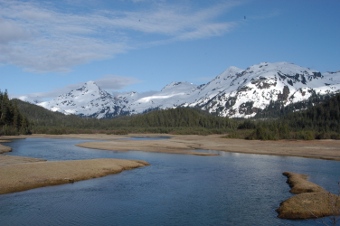Program Information

Wetlands provide a vital link between water and land. In the past, wetlands were regarded as wastelands and as places to avoid or, better yet, eliminate. Largely because of this negative view, more than half of America's original wetlands have been destroyed – drained and converted to farmland, filled for housing developments and industrial facilities, or used to dispose of household and industrial waste.
We now know that wetlands are, in fact, valuable natural resources. Whether drier or wetter, bigger or smaller, wetlands provide important benefits to people and the environment. Wetlands help regulate water levels within watersheds; improve water quality; reduce flood and storm damages; provide important fish and wildlife habitat; support fishing, and other recreational activities; and provide inspiration. Wetlands are natural wonderlands of great value.
WetlandsLIVE: A Distance Learning Adventure provides resources, activities and information about wetlands with for students and teachers. The webcasts and resources address the need for conservation education by providing students with a high-interest learning opportunity. Teachers can use this project as a resource to meet science standards, get students involved in citizen science, become wetland stewards, and become knowledgeable, engaged, and active conservationists.
Watch the webcasts and check out the other resources.
CLICK HERE to watch Wetland Connections videotaped at PANAMA BAY, PANAMA
Birds, fish, and other migratory species don’t recognize state or international borders and need wetlands and habitats located in many states and countries in order to survive. Learn how wetlands are connected.
CLICK HERE for wetland questions and answers from the webcast. The following experts answered questions during the web chat:
- Rosabel Miro, executive director of the Panama Audubon Society
- Zuleika Pinzon, Panama director of MarViva, an organization that supports the conservation and sustainable use of marine and coastal resources
- Erin Cooper, a biologist with the USDA Forest Services, who specializes in wetlands
- Jillian Jablonski with the USDA Forest Service
CLICK HERE to watch Discover Wetlands webcast from CORDOVA, ALASKA
May is American Wetlands Month and find out what students are doing to learn about, help, and engage in their local wetlands. Visit the Chugach National Forest in Alaska, which has the largest contiguous wetlands on the Pacific Coast of North America.
CLICK HERE to watch Wading into Wetlands webcast from VANCOUVER, CANADA
What exactly is a wetland? How does it function to benefit wildlife and people. We’ll visit some special wetlands to learn about wetland ecology, watersheds, their importance to migrating fish and birds, and much more.











